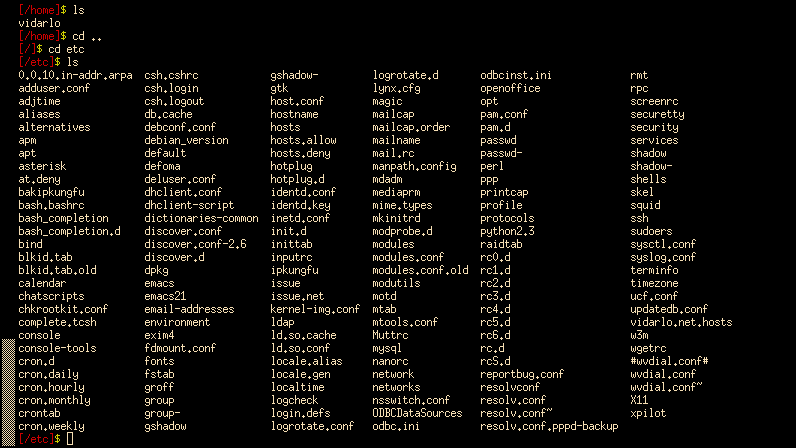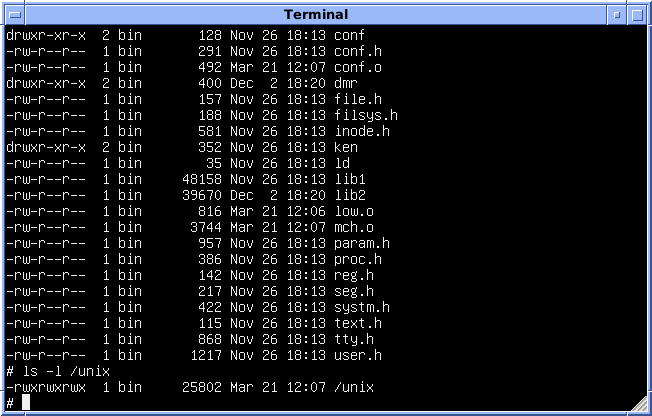|
Pseudoterminal
In some operating systems, including Unix-like systems, a pseudoterminal, pseudotty, or PTY is a pair of pseudo-device endpoints (files) which establish an asynchronous, bidirectional communication (IPC) channel (with two ports) between two or more processes. One pseudo-device in the pair, the ''master'', provides means by which a terminal emulator or remote login server (e.g. a Telnet, rlogin, or Secure Shell server) process controls the slave. The other pseudo-device, the ''slave'', emulates a hardware serial port device, and is used by terminal-oriented programs such as shells (e.g. bash) as a processes to read/write data back from/to ''master'' endpoint. PTYs are similar to bidirectional pipes. Devpts is a Linux kernel virtual file system containing pseudoterminal devices. Linux implementation is based on System V-style terminals (commonly referred as UNIX 98 pseudoterminals) and provides POSIX and the Single Unix Specification API in the form of a function since 1998. ... [...More Info...] [...Related Items...] OR: [Wikipedia] [Google] [Baidu] |
Devpts
devpts is a virtual filesystem directory available in the Linux kernel since version 2.1.93 (April 1998). It is normally mounted at /dev/pts and contains solely devices files which represent ''slaves'' to the multiplexing ''master'' located at /dev/ptmx which in turn is used to implement terminal emulators (such as X11 xterm). Terminal emulation A pseudoterminal ("pseudo TTY" or "PTY") is a pair of pseudo-devices – a ''slave'' and a ''master'' – that provide a special sort of communication channel. The slave pseudo-device emulates a physical computer text terminal (like, e.g. the DEC VT100) it can read and write text as though it was such a physical terminal. The ''master'' pseudo-device provides the means by which a program providing a text-based user interface acts with and controls its slave. Common use programs with a text-based user interface are terminal emulators (e.g. xterm, gnome-terminal or Konsole), or programs using SSH or telnet. Writing to the master is exa ... [...More Info...] [...Related Items...] OR: [Wikipedia] [Google] [Baidu] |
Terminal Emulator
A terminal emulator, or terminal application, is a computer program that emulates a video terminal within some other display architecture. Though typically synonymous with a shell or text terminal, the term ''terminal'' covers all remote terminals, including graphical interfaces. A terminal emulator inside a graphical user interface is often called a terminal window. A terminal window allows the user access to a text terminal and all its applications such as command-line interfaces (CLI) and text user interface (TUI) applications. These may be running either on the same machine or on a different one via telnet, ssh, dial-up, or over a direct serial connection. On Unix-like operating systems, it is common to have one or more terminal windows connected to the local machine. Terminals usually support a set of escape sequences for controlling color, cursor position, etc. Examples include the family of terminal control sequence standards that includes ECMA-48, ANSI X3.64, ... [...More Info...] [...Related Items...] OR: [Wikipedia] [Google] [Baidu] |
Digital Equipment Corporation
Digital Equipment Corporation (DEC ), using the trademark Digital, was a major American company in the computer industry from the 1960s to the 1990s. The company was co-founded by Ken Olsen and Harlan Anderson in 1957. Olsen was president until he was forced to resign in 1992, after the company had gone into precipitous decline. The company produced many different product lines over its history. It is best known for the work in the minicomputer market starting in the early 1960s. The company produced a series of machines known as the Programmed Data Processor, PDP line, with the PDP-8 and PDP-11 being among the most successful minis in history. Their success was only surpassed by another DEC product, the late-1970s VAX "supermini" systems that were designed to replace the PDP-11. Although a number of competitors had successfully competed with Digital through the 1970s, the VAX cemented the company's place as a leading vendor in the computer space. As microcomputers improved in t ... [...More Info...] [...Related Items...] OR: [Wikipedia] [Google] [Baidu] |
Inclusive Language
Inclusive language is a language style that seeks to avoid expressions that its proponents perceive as expressing or implying ideas that are sexist, racist, or otherwise biased, prejudiced, or insulting to particular group(s) of people; and instead uses language intended by its proponents to avoid offense and fulfill the ideals of egalitarianism, social inclusion and equity. Its aim is bias-free communication, that attempts to be equally inclusive of people of all ethnicities, gender identities, sexual orientations, religious affiliations, abilities, and ages by communicating in a way that makes no assumptions about the receiver of such communication. Its supporters argue that language is often used to perpetuate and spread prejudice and that creating intention around using inclusive language can help create more productive, safe, and profitable organizations and societies. The term " political correctness" is sometimes used to refer to this practice, either as a neutral ... [...More Info...] [...Related Items...] OR: [Wikipedia] [Google] [Baidu] |
Austin Group
The Austin Group or the Austin Common Standards Revision Group is a joint technical working group formed to develop and maintain a common revision of POSIX.1 and parts of the Single UNIX Specification. It is named after the location of the first meeting in Austin, Texas. The approach to specification development is "write once, adopt everywhere", with the deliverables being a set of specifications that carry the IEEE POSIX designation, The Open Group's Technical Standard designation, and the ISO/IEC designation. The new set of specifications is simultaneously ISO/IEC/IEEE 9945, and forms the core of the Single UNIX Specification Version 3. The IEEE formerly designated this standard as 1003.1. This unique development combines both the industry-led efforts and the formal standardization activities into a single initiative, and includes a wide spectrum of participants. The group currently has approximately 500 participants, and is chaired by Andrew Josey from The Open Group. The Op ... [...More Info...] [...Related Items...] OR: [Wikipedia] [Google] [Baidu] |
Single UNIX Specification
The Single UNIX Specification (SUS) is a standard for computer operating systems, compliance with which is required to qualify for using the "UNIX" trademark. The standard specifies programming interfaces for the C language, a command-line shell, and user commands. The core specifications of the SUS known as ''Base Specifications'' are developed and maintained by the Austin Group, which is a joint working group of IEEE, ISO/IEC JTC 1/SC 22/WG 15 and The Open Group. If an operating system is submitted to The Open Group for certification and passes conformance tests, then it is deemed to be compliant with a UNIX standard such as UNIX 98 or UNIX 03. Very few BSD and Linux-based operating systems are submitted for compliance with the Single UNIX Specification, although system developers generally aim for compliance with POSIX standards, which form the core of the Single UNIX Specification. The latest SUS consists of two parts: the ''base specifications'' technically iden ... [...More Info...] [...Related Items...] OR: [Wikipedia] [Google] [Baidu] |
System V
Unix System V (pronounced: "System Five") is one of the first commercial versions of the Unix operating system. It was originally developed by AT&T and first released in 1983. Four major versions of System V were released, numbered 1, 2, 3, and 4. System V Release 4 (SVR4) was commercially the most successful version, being the result of an effort, marketed as ''Unix System Unification'', which solicited the collaboration of the major Unix vendors. It was the source of several common commercial Unix features. System V is sometimes abbreviated to SysV. , the AT&T-derived Unix market is divided between four System V variants: IBM's AIX, Hewlett Packard Enterprise's HP-UX and Oracle's Solaris, plus the free-software illumos forked from OpenSolaris. Overview Introduction System V was the successor to 1982's UNIX System III. While AT&T developed and sold hardware that ran System V, most customers ran a version from a reseller, based on AT&T's reference implementation. A ... [...More Info...] [...Related Items...] OR: [Wikipedia] [Google] [Baidu] |
STREAMS
A stream is a continuous body of surface water flowing within the bed and banks of a channel. Depending on its location or certain characteristics, a stream may be referred to by a variety of local or regional names. Long, large streams are usually called rivers, while smaller, less voluminous and more intermittent streams are known, amongst others, as brook, creek, rivulet, rill, run, tributary, feeder, freshet, narrow river, and streamlet. The flow of a stream is controlled by three inputs – surface runoff (from precipitation or meltwater), daylighted subterranean water, and surfaced groundwater (spring water). The surface and subterranean water are highly variable between periods of rainfall. Groundwater, on the other hand, has a relatively constant input and is controlled more by long-term patterns of precipitation. The stream encompasses surface, subsurface and groundwater fluxes that respond to geological, geomorphological, hydrological and biotic controls. ... [...More Info...] [...Related Items...] OR: [Wikipedia] [Google] [Baidu] |
Version 8 Unix
Research Unix refers to the early versions of the Unix operating system for DEC PDP-7, PDP-11, VAX and Interdata 7/32 and 8/32 computers, developed in the Bell Labs Computing Sciences Research Center (CSRC). The term ''Research Unix'' first appeared in the Bell System Technical Journal (Vol. 57, No. 6, Part 2 July/August 1978) to distinguish it from other versions internal to Bell Labs (such as PWB/UNIX and MERT) whose code-base had diverged from the primary CSRC version. However, that term was little-used until Version 8 Unix (1985), but has been retroactively applied to earlier versions as well. Prior to V8, the operating system was most commonly called simply UNIX (in caps) or the UNIX Time-Sharing System. Ancient UNIX is any early release of the Unix code base prior to Unix System III, particularly the Research Unix releases prior to and including Version 7 (the base for UNIX/32V as well as later developments of AT&T Unix). History AT&T licensed Version 5 to educatio ... [...More Info...] [...Related Items...] OR: [Wikipedia] [Google] [Baidu] |
TENEX (operating System)
TENEX is an operating system developed in 1969 by BBN Technologies, BBN for the PDP-10, which later formed the basis for Digital Equipment Corporation's TOPS-20 operating system. Background In the 1960s, BBN Technologies, BBN was involved in a number of LISP-based artificial intelligence projects for DARPA, many of which had very large (for the era) memory requirements. One solution to this problem was to add ''paging'' software to the LISP language, allowing it to write out unused portions of memory to disk for later recall if needed. One such system had been developed for the PDP-1 at MIT by Daniel Murphy (computer scientist), Daniel Murphy before he joined BBN. Early Digital Equipment Corporation, DEC machines were based on an 18-bit computing, 18-bit word, allowing addresses to encode for a 256 kiloword memory. The machines were based on expensive magnetic-core memory, core memory and included nowhere near the required amount. The pager used the most significant bits of the ad ... [...More Info...] [...Related Items...] OR: [Wikipedia] [Google] [Baidu] |
PDP-11
The PDP–11 is a series of 16-bit minicomputers originally sold by Digital Equipment Corporation (DEC) from 1970 into the late 1990s, one of a set of products in the Programmed Data Processor (PDP) series. In total, around 600,000 PDP-11s of all models were sold, making it one of DEC's most successful product lines. The PDP-11 is considered by some experts to be the most popular minicomputer. The PDP–11 included a number of innovative features in its instruction set and additional general-purpose registers that made it easier to program than earlier models in the PDP series. Further, the innovative Unibus system allowed external devices to be more easily interfaced to the system using direct memory access, opening the system to a wide variety of peripherals. The PDP–11 replaced the PDP–8 in many real-time computing applications, although both product lines lived in parallel for more than 10 years. The ease of programming of the PDP–11 made it popular for general-pur ... [...More Info...] [...Related Items...] OR: [Wikipedia] [Google] [Baidu] |




